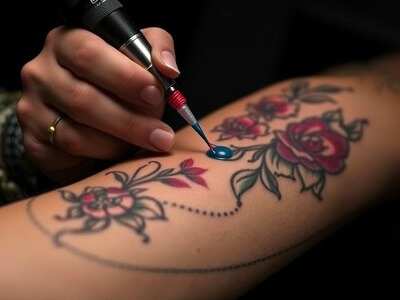 Getting a tattoo is an exciting and personal experience, but it also comes with a period of healing that requires attention and care. Understanding the stages of tattoo healing can help you navigate the process with confidence and ensure that your tattoo heals properly, without complications. Here’s what you can expect during each stage of the healing process:
Getting a tattoo is an exciting and personal experience, but it also comes with a period of healing that requires attention and care. Understanding the stages of tattoo healing can help you navigate the process with confidence and ensure that your tattoo heals properly, without complications. Here’s what you can expect during each stage of the healing process:
Stage 1: The Initial Healing (Days 1-5)
The first few days after getting your tattoo are crucial, as the skin begins its natural healing process. Right after the tattoo is completed, your skin may appear red, swollen, and tender. This is completely normal, as your skin has just undergone a procedure involving needles and ink.
During this stage, your tattoo will typically secrete some excess ink, blood, and plasma, which can form a thin layer of scabs. It’s important to follow your tattoo artist’s aftercare instructions closely, which usually involves keeping the area clean and applying an ointment or moisturizer. Be careful not to pick at or scratch the tattoo, as this could cause scarring or disrupt the healing process.
Stage 2: Peeling and Itching (Days 5-14)
As the initial swelling subsides, the skin will begin to peel and flake. This stage is often accompanied by itching, which can be uncomfortable but is a normal part of the healing process. The top layer of dead skin cells will naturally slough off, revealing fresh skin underneath.
While it may be tempting to scratch, avoid doing so to prevent damaging the tattoo. Instead, apply a fragrance-free moisturizer to alleviate the itching and keep the skin hydrated. The peeling should be light and won’t affect the design of the tattoo if you resist picking at it. This stage usually lasts for about one to two weeks, but the timing may vary depending on the size and placement of the tattoo.
Stage 3: Scabbing and Skin Regeneration (Days 10-21)
Around the second week, your tattoo may form light scabs or crusts. This is a normal part of the healing process, as your skin works to regenerate itself. The scabs will naturally fall off as the skin heals underneath. It’s important not to rush this process, as removing scabs prematurely can result in loss of pigment or scarring.
The skin should begin to feel less tender and more resilient at this stage. If you’ve been following proper aftercare, the tattoo should be looking more vibrant as the healing progresses. By the end of week three, most of the scabbing will have fallen off, and the skin will start to feel smoother.
Stage 4: Continued Healing (Weeks 3-6)
By the third or fourth week, the surface of the tattoo may appear healed, but the deeper layers of skin are still working to fully regenerate. At this stage, the tattoo will look vibrant, but the skin underneath may still be healing. It’s common for tattoos to appear slightly cloudy or dull in appearance during this stage, but this is temporary.
During this time, continue to moisturize the tattoo regularly and avoid exposing it to excessive sunlight. Your tattoo may still be sensitive to touch, but it should no longer be painful or swollen. The deeper layers of skin are still healing, which can take several weeks to months, depending on the size and complexity of the tattoo.
Stage 5: Fully Healed Tattoo (1-3 Months)
While the outer layers of your tattoo may seem healed after a few weeks, the complete healing process can take anywhere from one to three months, depending on factors like the tattoo’s size, placement, and your skin type. During this time, you may notice the colors of the tattoo becoming even more defined and vibrant as the skin fully settles.
By the end of this stage, your tattoo will be fully healed, and the skin underneath will have regenerated completely. However, it’s important to remember that tattoos may continue to change slightly over the course of several months as your skin continues to adapt to the ink.
Post-Healing Care
Once your tattoo has fully healed, it’s important to continue protecting it from sun damage by using sunscreen or keeping it covered when exposed to direct sunlight. Regular moisturizing can also help keep the skin soft and maintain the tattoo’s clarity.
Understanding the stages of tattoo healing can help you take proper care of your new ink, ensuring it heals quickly and maintains its appearance. With patience and proper aftercare, your tattoo will remain a beautiful piece of art for years to come.






